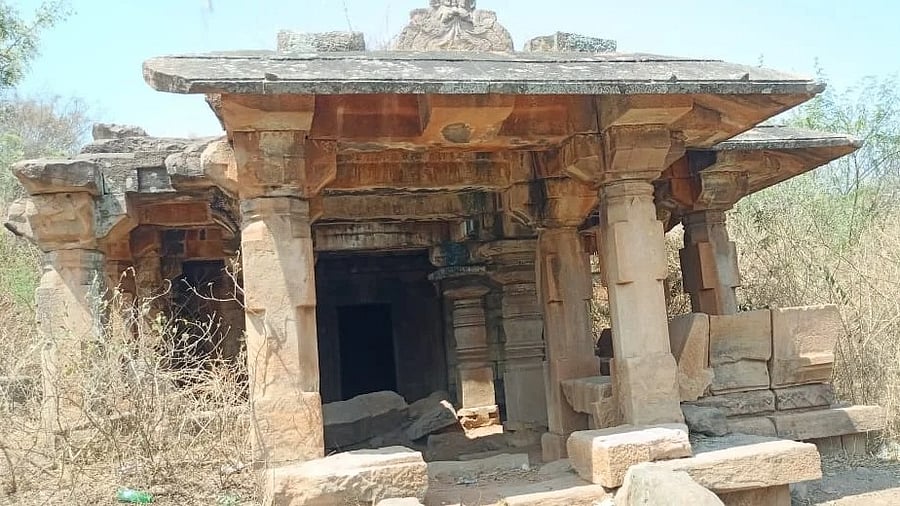
One of the dilapidated Jain temples at Arasibidi.
Credit: DH Photo
The Chalukyas of Kalyana (973 CE to 1184 CE) occupy a luminous place in the history of the country. Their reign was marked by egalitarian governance, valour in battle and magnificent achievements in art, architecture and literature. The empire was graced with not only valiant men but also formidable women whose prowess in governance and warfare often rivalled, or even surpassed, their male counterparts. One such remarkable figure was princess Akkadevi, whose reign stands as a testament to female strength and visionary leadership.
Akkadevi ruled an administrative division known as Kisukadu-70 (in addition to a few other divisions) from its capital city, Arasibidi. The term Kisukadu, in pre-old Kannada, means ‘land of red soil’. Arasibidi, located in present-day Ilkal taluk of Bagalkot district, was one of the sub-capitals of the Kalyana Chalukyas, established for seamless governance alongside the main capital, Basavakalyana, in today’s Bidar district. Locally, the place was known as Arasibuddi, a colloquial variation of Arasibidi, a name believed to mean either ‘the queen’s path’ or ‘the queen’s dwelling place’.
As per epigraphical records, Akkadevi was the daughter of Dashavarma and Bhagyavathi (Bhagaladevi), though she is often misidentified as the daughter of Vikramaditya V.
While the inscriptions at Jodu Kalasa temple in Sudi (in present-day Gadag district) calls Akkadevi as the younger sister of the ruler Vikramaditya V, other inscriptions and coins of that era hail her as Sri Gunada Bedangi or the beauty of virtues, an epithet that encapsulates both her grace and greatness. She was described as Bhairavi, a fierce incarnation of Goddess Durga, in the battlefield when she laid siege to Gokage fort (today’s Gokak) and was celebrated for her administrative acumen.
From 1010 CE onwards, Akkadevi’s rule extended across several regions, with Arasibidi (known in epigraphical records as Vikramapura) serving as her stronghold.
The city flourished under Akkadevi’s stewardship long before the time of Vikramaditya VI, the most celebrated emperor among all of the Kalyana Chalukya emperors, or his queen Jakaladevi, to whom the town’s construction is often mistakenly attributed. Vikramaditya-VI, who ascended the throne in 1076 CE, was the grandson of Akkadevi’s younger brother and hence, Arasibidi could have most probably been built during and named as Vikramapura after either Vikramaditya-IV or Vikramaditya-V.
Golden discovery
Recently, two gold coins embossed with Akkadevi’s epithet were discovered in Madugula, Telangana. The coins were handed to Munirathnam Reddy, director of epigraphy, Archaeological Survey of India (ASI) with the assistance of D Raja Reddy, a numismatist, for official authentication. These coins are academically called as Padma-Tankas in contradistinction to the commonly used phrase ‘punch marked gold coins’ and highlights the distinctive category of medieval Karnataka gold coinage.
Each coin bears the inscription Sri Gunada Bedangi in old Kannada language and script, reaffirming Akkadevi’s historical identity. These Padma-Tankas, named for their structural design, were once among the most widely circulated gold coins of medieval India. Their reputation was such that King Harsha of Kashmir (1089–1101 CE) issued imitative coinage modelled on them, a fact recorded by the 12th-century Kashmiri poet Kalhana in his Rajatarangini. Verse 926 in Book 7 of Rajatarangini describes how much these Padma-Tankas of medieval Karnataka were cherished and imitated throughout India.
The discovery of these coins adds a gleaming new chapter to the story of Karnataka’s numismatic heritage and provides a tangible link to the reign of one of its most dynamic women rulers.
A forgotten city
Once a bustling administrative hub, Arasibidi is a silent remnant of its glorious past. The landscape is dotted only with two dilapidated Jain temples, standing on either side of a narrow road atop a small hillock. A broken stone inscription on the ground stands as a poignant metaphor for the site’s present desolation. It is high time the state and central archaeological departments stepped in to preserve what remains of this lost capital, once alive with political vitality and cultural brilliance.
The gold coins embossed with Akkadevi’s epithet discovered in Telangana’s Madugula village recently.
Credit: ASI
One of the dilapidated Jain temples at Arasibidi.
Credit: DH Photo
A mutilated inscription on a stone slab at the Jain Temple, Arasibidi (present-day Ilkal taluk, Bagalkot district).
Credit: DH Photo